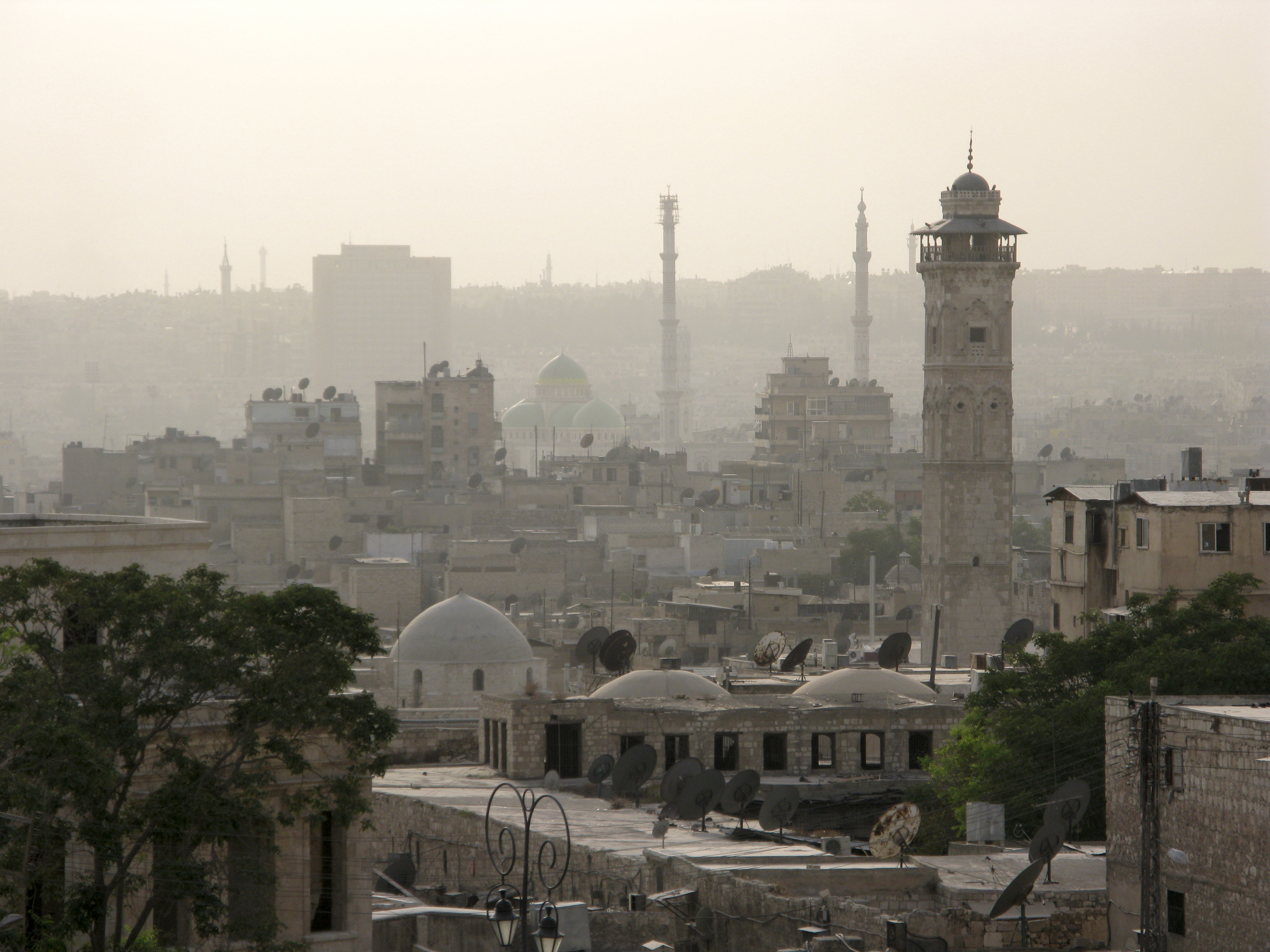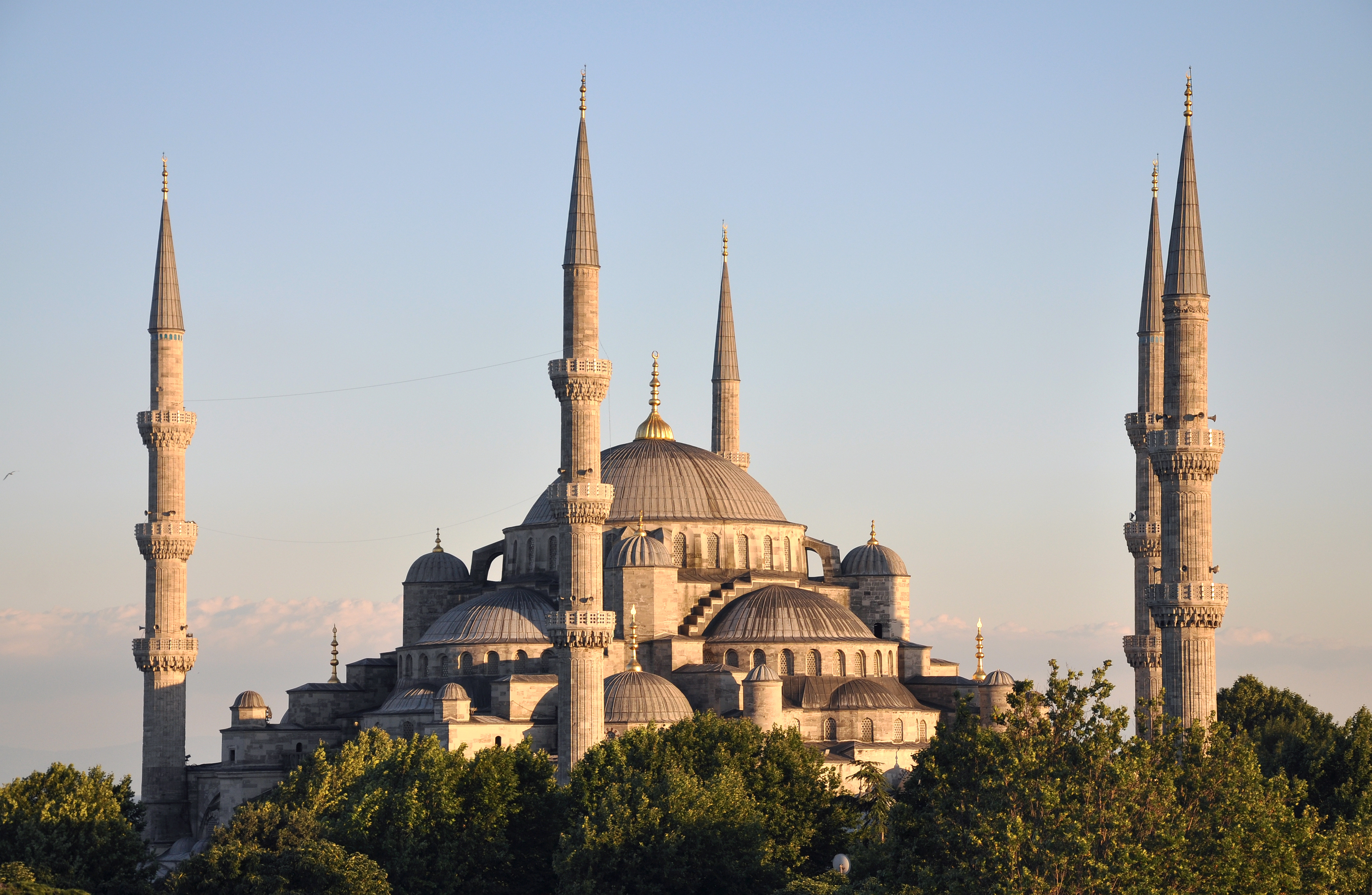|
Ar-Rahman Mosque (Aleppo)
Ar-Rahman Mosque ( ar, جَامِع ٱلرَّحْمَٰن, al-Jāmiʿ ar-Raḥmān) is a contemporary mosque in Aleppo, Syria, located on King Faisal Street. It was opened in 1994 and features a combined style of the early Umayyad architecture and modern mosques. It has a large central dome surrounded with 2 high and 4 shorter rectangular minarets. The external walls of the mosque are decorated with stones in the form of traditional Quran pages, inscribed with some verses from the Ar-Rahman sura. Gallery File:De moskee Ar-Rahman in aanbouw - Stichting Nationaal Museum van Wereldculturen - TM-20011817.jpg File:De moskee Ar-Rahman in aanbouw - Stichting Nationaal Museum van Wereldculturen - TM-20011816.jpg De moskee Ar-Rahman in aanbouw - Stichting Nationaal Museum van Wereldculturen - TM-20011815.jpg References Mosques completed in 1994 Architecture in Syria Umayyad architecture in Syria Mosques in Aleppo 20th-century mosques 1994 establishments in Syria ... [...More Info...] [...Related Items...] OR: [Wikipedia] [Google] [Baidu] |
Aleppo
)), is an adjective which means "white-colored mixed with black". , motto = , image_map = , mapsize = , map_caption = , image_map1 = , mapsize1 = , map_caption1 = , pushpin_map = Syria#Mediterranean east#Asia#Syria Aleppo , pushpin_label_position = left , pushpin_relief = yes , pushpin_mapsize = , pushpin_map_caption = Location of Aleppo in Syria , coordinates = , subdivision_type = Country , subdivision_name = , subdivision_type1 = Governorate , subdivision_type2 = District , subdivision_type3 = Subdistrict , subdivision_name1 = Aleppo Governorate , subdivision_name2 = Mount Simeon (Jabal Semaan) , subdivision_name3 = Mount Simeon ... [...More Info...] [...Related Items...] OR: [Wikipedia] [Google] [Baidu] |
Syria
Syria ( ar, سُورِيَا or سُورِيَة, translit=Sūriyā), officially the Syrian Arab Republic ( ar, الجمهورية العربية السورية, al-Jumhūrīyah al-ʻArabīyah as-Sūrīyah), is a Western Asian country located in the Eastern Mediterranean and the Levant. It is a unitary republic that consists of 14 governorates (subdivisions), and is bordered by the Mediterranean Sea to the west, Turkey to the north, Iraq to the east and southeast, Jordan to the south, and Israel and Lebanon to the southwest. Cyprus lies to the west across the Mediterranean Sea. A country of fertile plains, high mountains, and deserts, Syria is home to diverse ethnic and religious groups, including the majority Syrian Arabs, Kurds, Turkmens, Assyrians, Armenians, Circassians, Albanians, and Greeks. Religious groups include Muslims, Christians, Alawites, Druze, and Yazidis. The capital and largest city of Syria is Damascus. Arabs are the largest ethnic group, ... [...More Info...] [...Related Items...] OR: [Wikipedia] [Google] [Baidu] |
Islam
Islam (; ar, ۘالِإسلَام, , ) is an Abrahamic monotheistic religion centred primarily around the Quran, a religious text considered by Muslims to be the direct word of God (or ''Allah'') as it was revealed to Muhammad, the main and final Islamic prophet.Peters, F. E. 2009. "Allāh." In , edited by J. L. Esposito. Oxford: Oxford University Press. . (See alsoquick reference) " e Muslims' understanding of Allāh is based...on the Qurʿān's public witness. Allāh is Unique, the Creator, Sovereign, and Judge of mankind. It is Allāh who directs the universe through his direct action on nature and who has guided human history through his prophets, Abraham, with whom he made his covenant, Moses/Moosa, Jesus/Eesa, and Muḥammad, through all of whom he founded his chosen communities, the 'Peoples of the Book.'" It is the world's second-largest religion behind Christianity, with its followers ranging between 1-1.8 billion globally, or around a quarter of the world' ... [...More Info...] [...Related Items...] OR: [Wikipedia] [Google] [Baidu] |
Mosque
A mosque (; from ar, مَسْجِد, masjid, ; literally "place of ritual prostration"), also called masjid, is a Place of worship, place of prayer for Muslims. Mosques are usually covered buildings, but can be any place where prayers (sujud) are performed, including outdoor courtyards. The first mosques were simple places of prayer for Muslims, and may have been open spaces rather than buildings. In the first stage of Islamic architecture, 650-750 CE, early mosques comprised open and closed covered spaces enclosed by walls, often with minarets from which Adhan, calls to prayer were issued. Mosque buildings typically contain an ornamental niche (''mihrab'') set into the wall that indicates the direction of Mecca (''qiblah''), Wudu, ablution facilities. The pulpit (''minbar''), from which the Friday (jumu'ah) sermon (''khutba'') is delivered, was in earlier times characteristic of the central city mosque, but has since become common in smaller mosques. Mosques typically have Isl ... [...More Info...] [...Related Items...] OR: [Wikipedia] [Google] [Baidu] |
King Faisal Street
King Faisal Street ( ar, شارع الملك فيصل) is a main street in central Aleppo, Syria. Located to the northwest of the Saadallah Al-Jabiri Square connecting the Aleppo Public Park with Al-Sabil Park. The street ends up with Shihan Square to the north of the city centre. History King Faisal street was founded in 1919, to connect al-Jamiliyah district at the city centre with al-Sabil park, through the Syriac district. It was named in the honour of Faisal I the king of Syria. In 1964, the Saint Matilda Melkite Greek church was opened on the street. Later in 1994, Al-Rahman mosque was built on the street, adjacent to al-Sabil park. The street served as a highway A highway is any public or private road or other public way on land. It is used for major roads, but also includes other public roads and public tracks. In some areas of the United States, it is used as an equivalent term to controlled-access ... until 2008 when the separating green row of trees was rem ... [...More Info...] [...Related Items...] OR: [Wikipedia] [Google] [Baidu] |
Quran
The Quran (, ; Standard Arabic: , Quranic Arabic: , , 'the recitation'), also romanized Qur'an or Koran, is the central religious text of Islam, believed by Muslims to be a revelation from God. It is organized in 114 chapters (pl.: , sing.: ), which consist of verses (pl.: , sing.: , cons.: ). In addition to its religious significance, it is widely regarded as the finest work in Arabic literature, and has significantly influenced the Arabic language. Muslims believe that the Quran was orally revealed by God to the final prophet, Muhammad, through the archangel Gabriel incrementally over a period of some 23 years, beginning in the month of Ramadan, when Muhammad was 40; and concluding in 632, the year of his death. Muslims regard the Quran as Muhammad's most important miracle; a proof of his prophethood; and the culmination of a series of divine messages starting with those revealed to Adam, including the Torah, the Psalms and the Gospel. The word ''Quran'' occurs some ... [...More Info...] [...Related Items...] OR: [Wikipedia] [Google] [Baidu] |
Ar-Rahman
Ar-Rahman ( ar, الرحمان, ; The Merciful) is the 55th Chapter (''Surah'') of the Qur'an, with 78 verses ('' āyāt''). The title of the surah, Ar-Rahman, appears in verse 1 and means "The Most Beneficent". The divine appellation "ar-Rahman" also appears in the opening formula which precedes every surah except Sura 9 ("In the Name of God, the Lord of Mercy, the Giver of Mercy"). English translations of the surah's title include "The Most Gracious", "The All Merciful", "The Lord of Mercy", "The Beneficent", and "The Mercy-Giving". In the fourth century CE south Arabian pagan inscriptions started to be replaced by monotheistic expressions, using the term rahmān.Robert Schick, ''Archaeology and the Quran'', Encyclopaedia of the Qur'an There is disagreement over whether Ar-Rahman ought to be categorized as a surah of the Meccan or Medinan period. Theodor Nöldeke and Carl Ernst have categorized it among the surahs of the early Meccan period (in accordance with its s ... [...More Info...] [...Related Items...] OR: [Wikipedia] [Google] [Baidu] |
Sura
A ''surah'' (; ar, سورة, sūrah, , ), is the equivalent of "chapter" in the Qur'an. There are 114 ''surahs'' in the Quran, each divided into '' ayats'' (verses). The chapters or ''surahs'' are of unequal length; the shortest surah ('' Al-Kawthar'') has only three verses while the longest (''Al-Baqara'') contains 286 verses. Muhammad Mustafa Al-A'zami (2003), ''The History of The Qur'anic Text: From Revelation to Compilation: A Comparative Study with the Old and New Testaments'', p.70. UK Islamic Academy. . Of the 114 chapters in the Quran, 86 are classified as Meccan, while 28 are Medinan. This classification is only approximate in regard to the location of revelation; any chapter revealed after migration of Muhammad to Medina ('' Hijrah'') is termed Medinan and any revealed before that event is termed Meccan. The Meccan chapters generally deal with faith and scenes of the Hereafter while the Medinan chapters are more concerned with organizing the social life of the nasce ... [...More Info...] [...Related Items...] OR: [Wikipedia] [Google] [Baidu] |
Henk Van Rinsum
Henk is a Dutch male given name, originally a short form of Hendrik. It influenced "Hank" which is used in English-speaking countries (mainly in the US) as a form of "Henry". People named "Henk" include: Academics *Henk Aertsen (born 1943), Dutch Anglo-Saxon linguist *Henk Barendregt (born 1947), Dutch logician *Henk Jaap Beentje (born 1951), Dutch botanist *Henk Blezer (born 1961), Dutch Tibetologist, Indologist, and scholar of Buddhist studies *Henk Bodewitz (born 1939), Dutch Sanskrit scholar *Henk J. M. Bos (born 1940), Dutch historian of mathematics *Henk Braakhuis (born 1939), Dutch historian of philosophy * Henk Buck (born 1930), Dutch organic chemist *Henk van Dongen (1936–2011), Dutch organizational theorist and policy advisor *Henk Dorgelo (1894–1961), Dutch physicist and academic *Henk van der Flier (born 1945), Dutch psychologist *Henk A. M. J. ten Have (born 1951), Dutch medical ethicist *Henk van de Hulst (1918–2000), Dutch astronomer and mathematician *Henk Lom ... [...More Info...] [...Related Items...] OR: [Wikipedia] [Google] [Baidu] |
Nationaal Museum Van Wereldculturen
The (NMVW) () is an overarching museum organisation for the management of several ethnographic museums in the Netherlands, founded in 2014. It consists of the Tropenmuseum () in Amsterdam, the Afrika Museum in Berg en Dal, and the Museum Volkenkunde () in Leiden. The National Museum of World Cultures works in close cooperation with the Wereldmuseum () in Rotterdam. It is also part of nation-wide Dutch organisations for research into provenance studies and projects of restitution of cultural heritage to countries of origin, like the former Dutch colony in today's Indonesia. Structure and collections The Dutch National Museum of World Cultures (NMVW) was founded in 2014 by a merger of the Tropenmuseum in Amsterdam, the Museum Volkenkunde in Leiden and the Afrika Museum in Berg en Dal. It also oversees the Wereldmuseum in Rotterdam, whose collection belongs to that city. According to the museum's webpage, these collections contain "nearly 450,000 objects and 260,000 photo ... [...More Info...] [...Related Items...] OR: [Wikipedia] [Google] [Baidu] |
Mosques Completed In 1994
A mosque (; from ar, مَسْجِد, masjid, ; literally "place of ritual prostration"), also called masjid, is a place of prayer for Muslims. Mosques are usually covered buildings, but can be any place where prayers (sujud) are performed, including outdoor courtyards. The first mosques were simple places of prayer for Muslims, and may have been open spaces rather than buildings. In the first stage of Islamic architecture, 650-750 CE, early mosques comprised open and closed covered spaces enclosed by walls, often with minarets from which calls to prayer were issued. Mosque buildings typically contain an ornamental niche (''mihrab'') set into the wall that indicates the direction of Mecca (''qiblah''), ablution facilities. The pulpit (''minbar''), from which the Friday (jumu'ah) sermon (''khutba'') is delivered, was in earlier times characteristic of the central city mosque, but has since become common in smaller mosques. Mosques typically have segregated spaces for men and wo ... [...More Info...] [...Related Items...] OR: [Wikipedia] [Google] [Baidu] |

.jpg)



